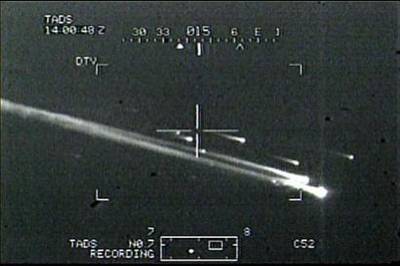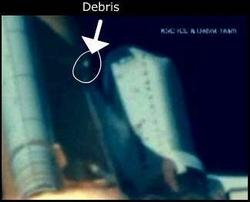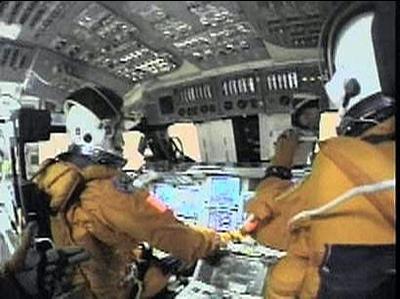CAIB Testimony Shows Computer Sim Ignored
The government-sponsored investigation into the destruction of
the space shuttle Columbia has confirmed what ANN first
reported last month (
Feb 24: "Is Columbia Investigation Plagued By
Inexperience?") - that engineers at shuttle contractor
Boeing blew off computer projections of a possible disaster as
faulty.

A computer simulation warned NASA's doomed Columbia
space shuttle faced potential disaster upon re-entry. Instead of
heeding the warning system, developed for precicely this scenario,
Boeing engineers rejected it as inaccurate by engineers, according
to testimony before the Columbia review board.
 Details of the alleged
blunder emerged as part of the official inquiry into the shuttle's
crash. The cause of the disintegration is still unknown.
Investigators, however, are more and more focused on the damage
done to Columbia's heat-shielding tiles by debris that
fell from the shuttle's fuel tank and slammed into its wing 82
seconds after take-off.
Details of the alleged
blunder emerged as part of the official inquiry into the shuttle's
crash. The cause of the disintegration is still unknown.
Investigators, however, are more and more focused on the damage
done to Columbia's heat-shielding tiles by debris that
fell from the shuttle's fuel tank and slammed into its wing 82
seconds after take-off.
The Boeing simulation, conducted while the orbiter was in still
circling the Earth, showed as many as 15 tiles from the shuttle's
heat shield may have been knocked off the underside of the left
wing by that debris. Knowing so many tiles were at risk would have
been a clear warning to NASA of impending disaster. But Boeing
engineers decided the computer had exaggerated the threat –
and their report to NASA assessed the risk on the basis that only
one tile had been damaged.
Sharing The Early Blame
Experts also blamed NASA for accepting Boeing's report –
parts of which were incomplete – without question.
 "NASA's acceptance of
that report, and the failure to go deeper, was fatally flawed,"
said Paul Fischbeck of Carnegie Mellon University in Pittsburgh, an
expert on shuttle tile damage who has given evidence to the
inquiry.
"NASA's acceptance of
that report, and the failure to go deeper, was fatally flawed,"
said Paul Fischbeck of Carnegie Mellon University in Pittsburgh, an
expert on shuttle tile damage who has given evidence to the
inquiry.
"It is something that will haunt this investigation and which
should haunt all those involved."
Details of the decision to overrule the simulation emerged in
papers submitted to the Columbia Accident Investigation
Board, which held its first public hearing last week in
Houston.
Senior engineers at Boeing's Huntington Beach (CA) facility,
asking to remain unnamed, said the STS-107 team of contractors
based at the Johnson Space Center in Houston (TX) were
inexperienced. The Huntington Beach engineers, some with more than
20 years' experience troubleshooting the space shuttles, said
STS-107 was the Houston team's first real-life experience with a
shuttle mission. The Boeing engineers in California said the
Houston study was so tragically flawed, that they've started their
own analysis of the damage caused to Columbia when the
chunks of insulating foam impacted the left wing shortly after
launch.

From Boeing: Only Silence So Far
Boeing has not publicly responded to the allegations and would
not comment last week. The inquiry is expected to call Boeing
engineers and executives to give evidence at a later date. Their
evidence may be crucial. The 13-strong CAIB inquiry panel is now
convinced that the shuttle was destroyed when gases, heated by the
extreme temperatures of re-entry, penetrated its heat shield. The
white-hot plasma is thought to have thought to have burned its way
into the shuttle's left wing, either through its leading edge or
through the landing gear compartment.
Evidence for this includes the discovery of molten aluminium on
some of the tiles seemingly confirming a 2000 degree meltdown of
the left wing.
"Eerily Prescient"
 But the blame for the accident
is spreading much further than Boeing. The inquiry also heard last
week how NASA had clear warnings that it was cutting safety margins
to the bone. Harry McDonald, the former Scottish-born director of
NASA's Ames Research Centre in California, described how he wrote a
report in 2000 highlighting the organisation's flawed
decision-making and poor communications over safety risks.
But the blame for the accident
is spreading much further than Boeing. The inquiry also heard last
week how NASA had clear warnings that it was cutting safety margins
to the bone. Harry McDonald, the former Scottish-born director of
NASA's Ames Research Centre in California, described how he wrote a
report in 2000 highlighting the organisation's flawed
decision-making and poor communications over safety risks.
The CAIB, which is leading the inquiry into Columbia's
break-up, described the report as "eerily prescient".
Dr McDonald said in his evidence last week that NASA engineers
lacked a fundamental understanding of risks and often failed to
detect subtle but potentially disastrous problems.
He also suggested that the safety recommendations he made in his
report might have saved the shuttle if they had not been
ignored.

Could the Columbia Seven Have Been Saved?
One key question for NASA is whether or not it could have done
anything to save the crew while in orbit if it had known about the
danger to it.
NASA and its contractors already are doing the planning and
engineering work necessary to launch another shuttle no later than
summer 2004, shuttle program sources told Florida
Today.
The work to recover from the accident and return to flight is
occurring parallel with the investigation into the cause of the
Columbia disaster so shuttles can launch as soon as
possible to support the International Space Station.
A manager in the shuttle program said separate work plans are
being developed based on a range of circumstances and dates, from
as early as this July and as late as summer 2004. Obviously the
findings of the Columbia investigation will dictate the
timeline, but NASA and shuttle contractors have decided to be smart
about using this down time rather than just waiting
around.
 SpaceX to Launch Inversion RAY Reentry Vehicle in Fall
SpaceX to Launch Inversion RAY Reentry Vehicle in Fall Aero-News: Quote of the Day (04.23.24)
Aero-News: Quote of the Day (04.23.24) Aero-News: Quote of the Day (04.20.24)
Aero-News: Quote of the Day (04.20.24) ANN's Daily Aero-Linx (04.20.24)
ANN's Daily Aero-Linx (04.20.24) Aero-News: Quote of the Day (04.21.24)
Aero-News: Quote of the Day (04.21.24)







